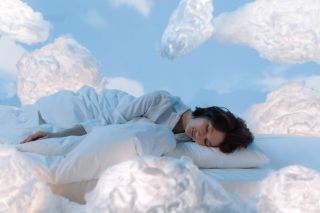Dreaming
Is Your Medication Giving You Nightmares?
Nightmares are a common side effect of many CNS medications.
Posted December 9, 2023 Reviewed by Ray Parker
Key points
- Many medications can disrupt sleep and cause nightmares, particularly those affecting a few neurotransmitters.
- Drugs designed to treat CNS disorders may alter the function of neurotransmitters that control dreaming.
- A better understanding of the cause of nightmares has led to drugs that show promise for treating nightmares.

All societies, cultures, and religions throughout history have offered their interpretation of dreams, especially nightmares. Today, clinicians rarely warn their patients that some medications may induce disturbing dreams and nightmares. Advancing knowledge on this problem has led to the development of drugs that can alleviate them.
Dreams occur throughout sleep. However, their complexity, physiology, and quality of recall after awakening are distinctly different between dreams during REM versus non-REM. Dreams recalled from REM sleep are highly visual, with a clear storyline and scenery, even though the content may be bizarre, illogical, and unrealistic. In contrast, dreams recalled during non-REM sleep are vague, without clear imagery, and often intimidating in character.
Medications and Nightmares.
Many patients who complain of nightmares are often taking a variety of medications. Investigation of reports on nightmares has led to a better understanding of shared mechanisms that allow the prediction of which drugs may cause nightmares. Certain neuropsychiatric and neurodegenerative conditions, such as Parkinson’s disease, as well as the medications used to treat them, may cause nightmares. Studies in healthy adults without neurological disease are preferable but more difficult to conduct.
We tend to think that we dream in bursts throughout the night. However, sleepers recall dreams about 50 percent of the time during non-REM sleep, also called slow-wave sleep, and about 80 percent of the time during REM sleep. (For more about sleep, see my book The Brain: What Everyone Needs to Know) This truly suggests that dreaming is more of a continuum during the entire night of sleep. We are probably not dreaming for only a small portion of the night.
Dreams change in quality as the night progresses. Dreams are more “thought-like” in the early night and then gradually transition into more “dream-like” content during the hours before waking.
Many common central nervous system (CNS) pharmaceuticals are designed to influence the same neurotransmitters that are responsible for this continuum of dreaming, leading to disorganized and disturbed dreams that feel like nightmares. Consider the following examples of drugs that alter the function of the neurotransmitters GABA, serotonin, norepinephrine, and dopamine that control non-REM and REM-related dreaming.
Alcohol imbalances the function of the neurotransmitter GABA, leading to decreased REM sleep during the first part of the night. As the alcohol is metabolized, GABA function returns to normal, and the brain attempts to enter REM sleep more often to compensate for the loss. This is called “REM pressure,” and it is always associated with nightmares. Barbiturates and the entire class of benzodiazepine drugs produce the same kind of REM pressure.
The selective serotonin reuptake inhibitor (SSRI) and serotonin and norepinephrine reuptake inhibitor (SNRI) anti-depressants alter the actions of serotonin and norepinephrine. These two neurotransmitters are responsible for taking the sleeping brain out of REM sleep into non-REM sleep. Consequently, these drugs cause the sleeping brain to spend less time in REM sleep. Most of the conventional anti-depressants lead to reduced REM time, fragmented sleep, increased abnormal dreams, and quite realistic nightmares.
The top four drugs that act upon norepinephrine receptors in the brain and body are used to treat high blood pressure and related cardiovascular problems, including pindolol, metoprolol, alprenolol, and propranolol, which are frequently associated with reports of nightmares.
Statins, including simvastatin, atorvastatin, and rosuvastatin, used to treat high levels of blood cholesterol, also cause nightmares. Statins that enter the brain may more easily cause more nightmares than statins that do not cross the blood-brain barrier. Statins may indirectly alter the function of serotonin and other neurotransmitters involved in the control of sleep and dreaming. Patients who reported the lowest levels of serum triglyceride, lower total cholesterol, and lower low-density lipoprotein (LDL) levels after taking statins also reported having more nightmares as compared to control subjects.
Cocaine and the amphetamine derivatives that alter the release of dopamine consistently induce a longer sleep latency, reduced total sleep time, and suppression of REM sleep, leading to REM pressure and nightmares. The effects of cannabis on sleep architecture are variable. However, reports of reduced total REM sleep have been consistent across studies. Subjects frequently report strange dreams as the cannabis dose wears off. Studies also report a REM rebound, a night with increased nightmares, after about one to three days after stopping cannabis use.
There are many ways that medications can disturb our dreams. Recently, some drugs have shown promise for treating nightmares, such as terazosin, clonidine, trazodone, some antihistamines, and gabapentin. Unfortunately, due to the variability in responses to these drugs, there are no clear recommendations about a “drug of choice” for the treatment of nightmares.
References
Bernath O, Ward R (2023) Pharmacology of dreaming. Somnologie, 27:158–168 https://doi.org/10.1007/s11818-023-00412-9




